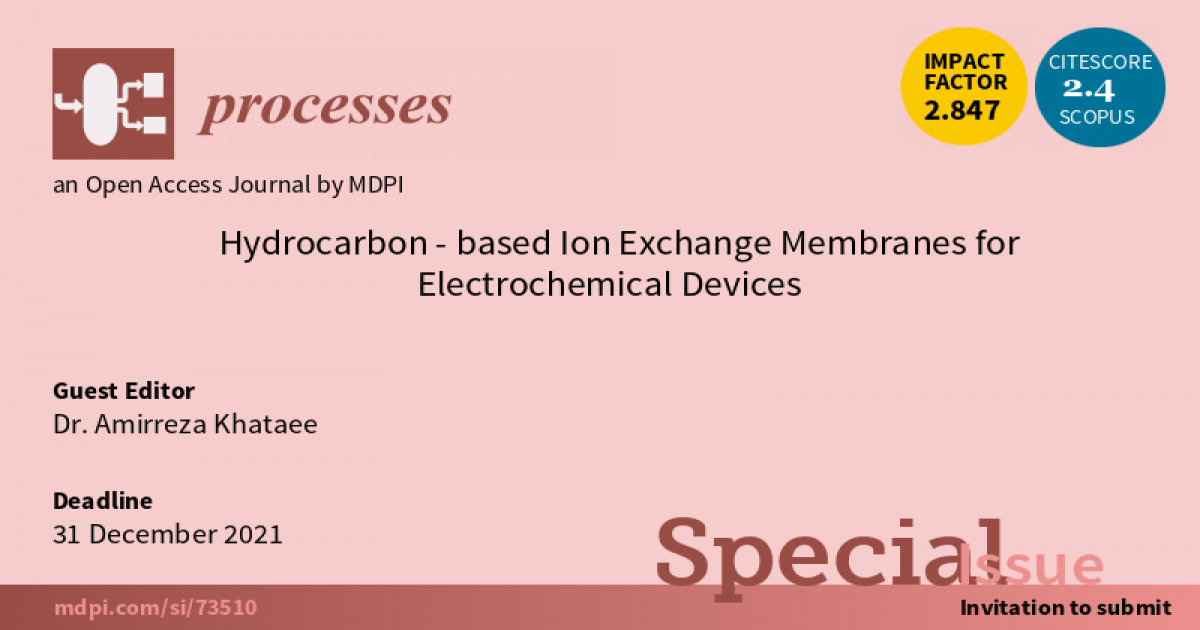Hydrocarbon-based Ion Exchange Membranes for Electrochemical Devices
A special issue of Processes (ISSN 2227-9717). This special issue belongs to the section "Materials Processes".
Deadline for manuscript submissions: closed (31 December 2021) | Viewed by 4273

Special Issue Editor
Special Issue Information
Dear Colleagues,
Nafion is considered the benchmark cation-exchange membrane (CEM) for most electrochemical devices, such as flow batteries, water electrolysis, and fuel cells. It shows excellent chemical and mechanical stability (Teflon backbone) and provides high ion conductivity. On the other hand, the high price (300–500 $/m2) and the low ion selectivity of Nafion have turned researchers’ attention to develop alternative ion-exchange membranes.
To achieve superior properties but at a lower total price than Nafion, different non-fluorinated hydrocarbon-based anion- and cation-exchange membranes have been developed. For instance, aliphatic (e.g., polyethylene), aromatic (e.g., polysulfone-based), and poly(phenyl)-based backbones carrying various cations, including ammonium, pyridinium, and imidazolium, have been studied. Therefore, getting improved and more economical ion-exchange membranes for electrochemical devices is crucial for the technology to be competitive.
This Special Issue aims to cover hydrocarbon-based ion-exchange membranes for electrochemical devices, including redox flow batteries, water electrolysis, and fuel cells, with regards to:
- Membrane materials;
- Preparation and characterization;
- Application and processes;
- Simulation and modeling.
Both original research and review papers are welcome.
Dr. Amirreza Khataee
Guest Editor
Manuscript Submission Information
Manuscripts should be submitted online at www.mdpi.com by registering and logging in to this website. Once you are registered, click here to go to the submission form. Manuscripts can be submitted until the deadline. All submissions that pass pre-check are peer-reviewed. Accepted papers will be published continuously in the journal (as soon as accepted) and will be listed together on the special issue website. Research articles, review articles as well as short communications are invited. For planned papers, a title and short abstract (about 100 words) can be sent to the Editorial Office for announcement on this website.
Submitted manuscripts should not have been published previously, nor be under consideration for publication elsewhere (except conference proceedings papers). All manuscripts are thoroughly refereed through a single-blind peer-review process. A guide for authors and other relevant information for submission of manuscripts is available on the Instructions for Authors page. Processes is an international peer-reviewed open access monthly journal published by MDPI.
Please visit the Instructions for Authors page before submitting a manuscript. The Article Processing Charge (APC) for publication in this open access journal is 2400 CHF (Swiss Francs). Submitted papers should be well formatted and use good English. Authors may use MDPI's English editing service prior to publication or during author revisions.
Keywords
- Hydrocarbon-based ion-exchange membranes
- Non-fluorinated ion-exchange membranes
- Energy storage
- Redox flow battery
- Water electrolysis
- Fuel cell
- Electrochemical device





